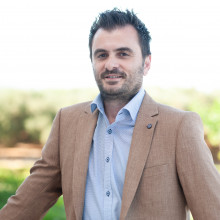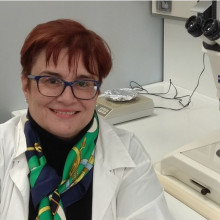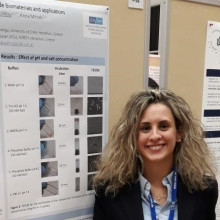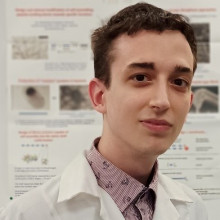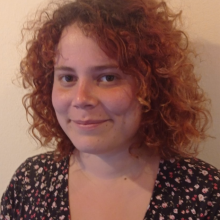Position Description
The Institute of Electronic Structure and Laser of the Foundation for research and Technology Hellas (IESL -FORTH), in the framework of the project POWERSAT, (P.I.: Prof. G. Konstantinidis, Call: HORIZON-EIC-2023-PATHFINDERCHALLENGES-01, GA 101162320), funded under HORIZON-EIC - HORIZON EIC Grants, is seeking to recruit one (1) master student.
Job Description
Electrical characterization of III-N semiconductor heterostructures and micro/nano-devices. Design, implementation and conduct of sensitive/low-noise electrical measurements of III-N semiconductors heterostructures and micro/nano devices.
For the full announcement, follow the link "Related Documents"
Required Qualifications
- B.Sc in Physics or relative field
- Registered student in Nanoelectronics M.Sc. student
- Experience in low noise electrical measurements of semiconductor heterostructures
Desirable Qualifications
- Experience on design of circuits for low noise electrical instrumentation
- Experience in DC characterization in micro/nano devices
Application Procedure
In order to be considered, the application must include:
- Application Form (please download file from the job announcement webpage https://www.iesl.forth.gr/en/jobs-bids/jobs/job-positions)
- Detailed curriculum vitae (CV) of the candidate
- Scanned Copies of academic titles
- Certificate for enrollment in a master’s program
Any application received after the deadline will not be considered for the selection
Please send your application and all documents to: hr@iesl.forth.gr and cc the Scientific supervisor marked in the left column
Appointment Duration
12Position Description
Χρήση ελλειψομέτρου βασισμένο σε οπτική κοιλότητα, με
χρονική απόκριση μs, για μετρήσεις (in situ) του πάχους της
λιπώδους και της υδατώδους στιβάδας των δακρύων.
Για το πλήρες κείμενο της πρόσκλησης ακολουθήστε τον σύνδεσμο 'Related Documents'
Required Qualifications
- Μεταπτυχιακό στις Φυσικές επιστήμες
- Εμπειρία στην ανάπτυξη πειραματικών διατάξεων
- Εμπειρία με παλμικά λέιζερ
- Εμπειρία σε φασματοσκοπία
- Άριστη γνώση Αγγλικής γλώσσας
Application Procedure
Στο φάκελο υποβολής της πρότασης θα πρέπει να εμπεριέχονται τα ακόλουθα:
- Αίτηση (Form Greek στην αριστερή στήλη) με αναφορά στον κωδικό της θέσης και στο όνομα του προγράμματος
- Αναλυτικό Βιογραφικό Σημείωμα
- Ευκρινή φωτοαντίγραφα τίτλων σπουδών
- Πρόσφατη βεβαίωση σπουδών
ΥΠΟΒΟΛΗ ΠΡΟΤΑΣΕΩΝ
Οι ενδιαφερόμενοι καλούνται να υποβάλουν τις αιτήσεις τους και όλα τα απαραίτητα δικαιολογητικά, ηλεκτρονικά στη διεύθυνση hr@iesl.forth.gr με κοινοποίηση (cc): στον Καθηγ. Π. Ρακιτζή (ptr@iesl.forth.gr). Οι αιτήσεις θα πρέπει να αποσταλούν με την ένδειξη: «Αίτηση στο πλαίσιο του προγράμματος TEARSENSE, της πρόσκλησης εκδήλωσης ενδιαφέροντος με Α.Π. … και κωδικό θέσης … » (όπως αυτός αναφέρεται στον Πίνακα του Παραρτήματος).
Appointment Duration
8Position Description
The PhD candidate will work on the fabrication of polymeric nanocomposite materials with multifunctional properties varying from energy harvesting devices to heating insulators for buildings and constructions, following the Fused Deposition Modeling (FDM) 3D printing technique.
Related Project
Exploit4InnoMat -Required Qualifications
- Bachelor's degree (B.Sc.) from Materials Science and Technology dpt. or a related school (20%)
- Postgraduate Diploma in a School of Sciences or a related school (20%)
- Technical skills: Mechanical properties of materials determined by engineering tests (tensile test, hardness tests etc.); In-depth knowledge of programming languages; (20%)
- Scientific publication(s) and/or presentations in international scientific conferences and workshops (20%)
- Effective Communication & Presentation Skills; Excellent knowledge of Greek and English (20%)
Application Procedure
Interested candidates who meet the aforementioned requirements are kindly asked to submit their applications to the address (hr@iesl.forth.gr), with cc to the Scientific Coordinator Dr George Kenanakis (gkenanak@iesl.forth.gr).
In order to be considered, the application must include:
- Application Form (Form Greek or Form English to the left)
- Detailed curriculum vitae (CV) of the candidate
- Scanned Copies of academic titles
- Certificate for enrollment in PhD program
Appointment Duration
9 monthsFunding

Position Description
Driving of spatial photonic Ising machine with controlled source of quantum light.
For the full announcement, follow the link "Related Documents"
Related Project
HEISINGBERG -Required Qualifications
- Degree in Physics (30%)
- Master in Physics (30%)
- Laboratory experience in optical setups (10%)
- Two (2) reference letters (10%)
Desirable Qualifications
- Experience in computational modelling of condensed matter systems (10%)
- Fluency in English (10%)
Application Procedure
Interested candidates who meet the aforementioned requirements are kindly asked to submit their applications to the address (hr@iesl.forth.gr), with cc to Prof. P. Savvidis (psav@materials.uoc.gr).
In order to be considered, the application must include:
- Application Form (Form Greek or Form English to the left)
- Detailed curriculum vitae (CV) of the candidate
- Scanned Copies of academic titles
- Certificate for enrollment in a PhD program
Appointment Duration
12 Months with possibility of extension according to the needs of the projectΤο έργο θα επιτελέσει έρευνα στον τομέα των υλικών και μεταϋλικών με στόχο την ανάπτυξη καινοτόμων εύκαμπτων και φορετών μεταϋλικών απορροφητών ηλεκτρομαγνητικής (ΗΜ) ακτινοβολίας με χρήση τεχνολογιών εκτύπωσης. Το έργο θα οδηγήσει έτσι στην ανάπτυξη νέων εμπορικών προϊόντων υλικών προστασίας από την ΗΜ ακτινοβολία που θα είναι ελαφριά, χαμηλού κόστους, εύχρηστα, και με μοναδικά τεχνικά χαρακτηριστικά όπως η λειτουργία σε μεγάλο εύρος συχνοτήτων. Τα προϊόντα θα παρέχουν την καλύτερη λύση για την προστασία εξοπλισμού και προσωπικού σε χώρους με ισχυρή ΗΜ ακτινοβολία, όπως αυτούς στην επιφάνεια και λοιπούς χώρους πλοίων όπου λειτουργούν πομποί υψηλής ισχύος. Τα μεταϋλικά είναι τεχνητά δομημένα υλικά που αποτελούνται από περιοδικά στοιχεία (unit cells) μικρότερα του μήκους κύματος της συχνότητας συντονισμού της γεωμετρίας του μεταϋλικού, και μπορούν να σχεδιασθούν για την δημιουργία επιφανειών με εξωτικές ΗΜ ιδιότητες (π.χ. αρνητικός δείκτης διάθλασης) που δεν συναντώνται στην φύση. Τα τελευταία δέκα χρόνια, μια από τις σημαντικότερες εφαρμογές αυτής της σημαντικής τεχνολογικής ανακάλυψης είναι οι “μεταϋλικοί τέλειοι απορροφητές” (perfect metamaterial absorbers – MPA’s), οι οποίοι μπορούν να απορροφήσουν ΗΜ ακτινοβολία σε ποσοστά πάνω από 90%, ενώ απαιτούν πολύ μικρότερο πάχος από συμβατικές διατάξεις απορρόφησης ΗΜ ακτινοβολίας. Η συγκεκριμένη πρόταση στοχεύει στην δημιουργία μιας έξυπνης, εύκαμπτης και ελαφριάς δομής με ευρεία ζώνη λειτουργίας στο εύρος τηλεπικοινωνιακών συχνοτήτων που χρησιμοποιούνται σε ραντάρ και άλλες τηλεπικοινωνιακές εφαρμογές. Παρόλο που απορροφητικά μεταϋλικά έχουν αναπτυχθεί για πάνω από μια δεκαετία, η προτεινόμενη εφαρμογή καινοτομεί προτείνοντας μεταϋλικά που θα ειναι όχι μόνο ευρείας ζώνης λειτουργίας στο πεδίο των συχνοτήτων, αλλά και εύκαμπτα, με πολύ μικρό πάχος, επιτρέποντας τη μετατροπή τους σε προστατευτική ένδυση.
Funding

The Natural Biomaterials team focuses on developing self-assembling, bioinspired nanomaterials targeted for novel applications. The design of such self-assembling protein and peptide building blocks is often achieved by drawing inspiration of from natural fibrous proteins such as collagen, elastin, silk and spider silks that are built up from repetitive sequences. Self-assembling proteins and peptides are water soluble and biocompatible nanostructures formed spontaneously under mild conditions through non-covalent interactions. They form supramolecular structures such as ribbons, nanotubes and fibers, which often form gels. Protein and peptide based-nanostructures can assemble under mild conditions, though they can withstand elevated temperatures, detergents and denaturants following their assembly. Moreover, the wide range of chemical functionalities found in peptides (ie 20 amino acids) enables the design and engineering of specific interactions with target materials for potential technological applications. Technologically, the self-organized structures can be used as templates for the growth of inorganic materials, such as metals (silver, gold and platinum), silica, calcium phosphates etc. Self-assembling peptides may also create hydrogels and entangled fibrous networks that can be used as scaffolds for attachment, growth and proliferation of living cells, allowing tissue repair and engineering. Therefore, in recent years the study of the properties of self-organization has created a separate area of research, ranging from biomedicine and biotechnology to materials science and nanotechnology. Overall, our team focuses on how to translate fundamental structural knowledge from natural fibrous proteins into concrete integration strategies and applications in the area of fibrous bio-nano-materials.
The team combines therefore expertise in biochemistry, structural biology, biotechnology, nanosciences, material engineering and micronanofabrication, thus going beyond the state of the art methods used in traditional (nano)biotechnology and bioengineering. We have been involved for a number of years in the rational design, synthesis and characterization of self-assembling proteins and peptides following identification of building blocks in natural fibrous proteins such as viral fibers. Such short self-assembling peptides that are amenable to rational design offer open-ended possibilities towards multifunctional material scaffolds of the future. Last but not least, we also foster interdisciplinary collaborations with colleagues that develop techniques to manipulate, assemble and position these materials in a controlled manner and we have a long term collaboration with Dr. Maria Farsari of IESL.
Position Description
The Institute of Electronic Structure and Laser of the Foundation for research and Technology Hellas (IESL -FORTH), in the framework of the project PHOTOENERGY is seeking to recruit one lab technician Position Description.
The technician is expected to join the proteomic facility of IMBB (ProFI) and perform statistical/bioinformatic analysis of the Mass Spectrometry (MS) pipeline established to characterize the proteome of diatoms and how this is affected depending on growth conditions at different light wavelengths and intensities. The technician will also participate in cultivation of diatoms and protein analysis by SDS-PAGE electrophoresis
Required Qualifications
- Bachelor degree (B. Sc) in biochemistry preferably but also chemistry or biology
- MS.c. degree in biological or physicochemical sciences
- Ph.D. dissertation related to protein biochemistry and/or mass spectrometry
- Experimental laboratory experience in protein expression and purification and MS characterization of proteins
- Knowledge of English language
Desirable Qualifications
- Experience in MS Data analysis and in using sample preparation methodologies for proteomics analysis
Application Procedure
Interested candidates who meet the aforementioned requirements are kindly asked to submit their applications to the address (hr@iesl.forth.gr), with cc to the Scientific Responsible, Dr P. Loukakos (loukakos@iesl.forth.gr).
In order to be considered, the application must include:
- Application Form (Form Greek or Form English to the left)
- Detailed curriculum vitae (CV) of the candidate
- Scanned Copies of academic titles
Appointment Duration
5 monthsAustin Nevin is the Head of the Department of Conservation, at the Courtauld Institute of Art that unites Easel Painting and Wall Painting Conservation with transdisciplinary research on preventive conservation, technical art history, conservation science and conservation practice. His research focuses on the conservation and analysis of paintings, ancient and modern art on walls, easels and on paper and ranges from Chinese wall paintings to the analysis of Egyptian Polychromy and the analysis of red pigments from Leonardo´s The Last Supper. Trained as a conservator and conservation scientist he has worked as a Senior Lecturer at the University of Gothenburg and taught at the Accademia di Brera in Milan. Between 2011-2019 he was a Researcher at the Istituto di Fotonica e Nanotecnologie (IFN) in Milan, part of the Italian National Research Council. He completed post doctoral research at the Department of Physics at the Politecnico di Milano on applications of time resolved fluorescence spectroscopy to cultural heritage. Between 2004-2007 he was a Marie Curie Early Stage Research Fellow at the Foundation for Research and Technology (IESL-FORTH). Following a degree in Chemistry from the University of Oxford (2001), he obtained an MA in the Conservation of Wall Painting (2004) and a PhD at The Courtauld (2008). He is a Vice President and Fellow of the International Institute for the Conservation of Artistic and Historic and is an Editor of Studies in Conservation and of the Springer Series Cultural
Education
- 2004-10-01 to 2008-07-21 | PhD (Conservation ), Courtauld Institute of Art: London, London, GB
- 2001-10-01 to 2004-07-30 | MA in the Conservation of Paintings (Wall Paintings) (Conservation of Wall Paintings) Education, Courtauld Institute of Art: London, London, GB
- 1997-10-01 to 2001-10-21 | MChem (Lady Margaret Hall), University of Oxford: Oxford, Oxfordshire, GB
Career
- 2020-09-01 to present | Head of Department (Department of Conservation) Employment, Courtauld Institute of Art: London, GB
- 2019 to 2020-08-30 | Senior lecturer, University of Gothenburg: Gothenburg, SE
- 2011-12-01 to 2019-02-01 | Researcher, Istituto di Fotonica e Nanotecnologie Consiglio Nazionale delle Ricerche: Milano, Lombardia, IT
Position Description
Ανάπτυξη ισχυρών πηγών THz από στερεά μέσα. Πειραματική εργασία στην ανάπτυξη ισχυρών πηγών THz από στερεά μέσα.
Για το πλήρες κείμενο της πρόσκλησης ακολουθήστε τον σύνδεσμο 'Related Documents'
Related Project
ENTERS -Required Qualifications
- Πτυχίο Φυσικής, Επιστήμης Υλικών ή Αντίστοιχων
- Μεταπτυχιακό Φυσικής, Επιστήμης Υλικών ή Αντίστοιχων
Desirable Qualifications
- Εμπειρία σε λέιζερ υπέρστενων παλμών και σχετικών πειραματικών διατάξεων με έμφαση στις διατάξεις THz
- Γνώση Αγγλικής γλώσσας
- Δημοσιεύσεις σχετικές με το ερευνητικό αντικείμενο
Application Procedure
Στο φάκελο υποβολής της πρότασης θα πρέπει να εμπεριέχονται τα ακόλουθα:
- Αίτηση (form Greek στην αριστερή στήλη) με αναφορά στον κωδικό της θέσης και στο όνομα του προγράμματος
- Αναλυτικό Βιογραφικό Σημείωμα
- Ευκρινή φωτοαντίγραφα τίτλων σπουδών
- Πρόσφατη βεβαίωση σπουδών υποψήφιου διδάκτορα
ΥΠΟΒΟΛΗ ΠΡΟΤΑΣΕΩΝ
Οι ενδιαφερόμενοι καλούνται να υποβάλουν τις αιτήσεις τους και όλα τα απαραίτητα δικαιολογητικά, ηλεκτρονικά στη διεύθυνση hr@iesl.forth.gr με κοινοποίηση (cc): στον Καθηγ. Στ. Τζωρτζάκη (stzortz@iesl.forth.gr). Οι αιτήσεις θα πρέπει να αποσταλούν με την ένδειξη: «Αίτηση στο πλαίσιο του προγράμματος ENTERS, της πρόσκλησης εκδήλωσης ενδιαφέροντος με Α.Π. … και κωδικό θέσης … » (όπως αυτός αναφέρεται στον Πίνακα του Παραρτήματος).
Appointment Duration
7Funding



